Question 1.
Fill in the blanks and complete the statements.
a. Methods like artificial insemination and embryo transplant are mainly used for ………..
(a) animal husbandry
(b) wild life
(c) pet animals
(d) for infertile women
Answer:
(a) animal husbandry
b. ……….. is the revolutionary event in biotechnology after cloning.
(a) Human genome project
(b) DNA discovery
(c) Stem cell research
(d) All the above
Answer:
(c) Stem cell research
c. The disease related with the synthesis of insulin is …………..
(a) cancer
(b) arthritis
(c) cardiac problems
(d) diabetes
Answer:
(d) diabetes
d. Government of India has encouraged the ……….. for improving the productivity by launching NKM-16.
(a) aquaculture
(b) poultry
(c) piggery
(d) apiculture
Answer:
(a) aquaculture
Question 2.
Match the pairs.
| Column ‘A’ | Column ‘B’ |
| (1) Interferon | (a) Diabetes |
| (2) Factor VIII * | (b) Dwarfness |
| (3) Somatostatin | (c) Viral infection |
| (4) Interleukin | (d) Cancer |
| (e) Haemophilia |
[Note: In examination match the column question will have 2 components in Column A’ with 4 alternatives in Column B’.]
Answer:
(1) Interferon – Viral infection
(2) Factor VIII – Haemophilia
(3) Somatostatin – Dwarfness
(4) Interleukin – Cancer
[Note: Factor VIII* is an important protein factor and it should not be just factor as given in the textbook.]
Question 3.
Rewrite the following wrong statements after corrections:
a. Changes in genes of the cells are brought about in non-genetic technique.
Answer:
Non-genetic biotechnology involves use of either cell or tissue.
b. Gene from Bacillus thuringiensis is introduced into soyabean.
Answer:
Gene from Bacillus thuringiensis is introduced with gene of cotton.
Question 4.
Write short notes.
a. Biotechnology: Professional uses. (Commercial uses)
Answer:
(1) Biotechnology can be used in the following professional fields, viz. crop biotechnology, animal husbandry, human health, etc.
(2) In crop biotechnology, improvement in the yield and variety of agricultural field is done. The hybrid seeds, genetically modified crops, herbicide tolerant plants are some of the areas in which lot of biotechnological research is being done. By such research, high yielding and disease resistant varieties and varieties which can tolerate stresses such as alkalinity, weeds, cold and drought etc. are produced. BT cotton, BT Brinjal and golden rice are some GMO plants which have become popular in India.
Due to herbicide tolerant plants, the weeds are now selectively destroyed. By using biofertilizers, the use of chemical fertilizers is reduced. Use of bacteria such as Rhizobium, Azotobacter, Nostoc, Anaixiena and plants like Azolla the nitrogen fixation and phosphate solubilization abilities of the plants are improved.
(3) Animal husbandry is now using the methods of artificial insemination and embryo transfer by which the breeds of cattle are improved.
(4) To improve and to manage the human health, diagnosis ahd treatment of diseases have to be focussed. Diagnosis of diabetes, heart diseases and infectious diseases such as AIDS and dengue can be done rapidly due to biotechnology.
(5) The treatment and prevention of diseases need hormones, interferons, antibiotics and different vaccine which are now manufactured through biotechnology. Gene therapy is also used to treat hereditary disorders.
(6) Industrial products and clean technology to combat environmental pollution uses biotechnology practices.
(7) DNA fingerprinting has revolutionized the profession of forensic science.
b. Importance of medicinal plants.
Answer:
- In Ayurveda practices, the natural remedies were used. Since India had great biodiversity and traditional knowledge of herbal medicinal uses, therefore, people depended on such medicinal plants.
- In olden days, such herbs were collected by roaming in the jungles.
- Such important medicinal herbs are now cultivated with care.
- In entire world people have understood the importance of holy basil (tulsi), Adulsa, Jyesthmadh, etc.
- In some of the allopathy medicines too, the plant extracts are used.
- Medicines made from harmful chemicals have side effects and are not safe to be used unless there is medical supervision. Therefore, world-wide herbal remedies are gaining more popularity.
Question 5.
Answer the following questions in your own words.
a. Which products produced through biotechnology do you use in your daily life?
Answer:
- The simplest use of biotechnology that we practice at home is making curd and buttermilk.
- The primary type of biotechnology is used in the process of fermentation while making food stuffs, like bread, idli-dosa, dhokla, etc.
- Nowadays, different types of cheese, paneer, yoghurt, energy drinks, etc. are produced with the help of biotechnology. We are consuming these in our daily life.
- Seedless grapes, papaya, and watermelons are available in the market these days.
- Violet cabbage, yellow capsicum and exotic vegetables used for salad are also biotechnology products.
- The vaccines, antibiotics and the injections of human insulin are in regular use in many house-holds.
b. Which precautions will you take during spraying of pesticides?
Answer:
- Pesticides are toxic chemicals. By using them indiscriminately, they contaminate the water, soil and also crops.
- The D.D.T., chloropyriphos and malathion are very dangerous. They spread through the food chain causing biomagnification.
- Therefore, we shall not use such insecticides and pesticides. We shall use organic pesticides. Excessive use will be avoided.
- At the time of spraying, nose, eyes and skin will be covered and protected.
- Care will be taken not to allow children or domestic animals to come in, contact with a pesticide.
c. Why some of the organs in human body are most valuable?
Answer:
- The body can be in best health,if all the vital organs of the body are also in the best condition.
- Brain, kidney, heart, liver, etc. are some such vital organs which are most essential for proper metabolism and functioning of the body. The sense organs of the body are also of utmost importance, especially eyes.
- One cannot survive if any of these vital organs are not functioning properly. Some of the organs like brain will never regenerate too.
- Some of the organs can be brought back to functionality by performing surgeries. However, any problem with these vital organs make life miserable, therefore, they are said to be valuable.
d. Explain the importance of fruit processing in human life?
Answer:
(1) Fruits are perishable food stuff. They are spoilt soon if not consumed immediately. Hence for storage and usage for a long term, their preservation is absolutely essential.
(2) For year-long use of the fruits they are dried, salted, packed in air tight containers, used for preparing jams and jellies or condensed into pulps or syrups. Beverages, pickles, sauce, and various other products made from the fruits are largely used by us.
(3) The preserved products also fetch financial benefits.
(4) In national and international markets, Indian fruits like mangoes are in great demand. We can get foreign currency through exports of fruits and fruit products. The local horticulturists get good benefit from their orchards.
(5) Processed fruit products also give vitamins and minerals that help in maintaining good health. Thus fruit processing is important for human life.
e. Explain the meaning of vaccination.
Answer:
- Vaccination is the administering of vaccine. Vaccine is the ‘antigen’, given to a person or even to animals for acquiring immunity against particular pathogens or diseases.
- In olden days, vaccipes were prepared with the help of completely or partially killed pathogens. But this method causes some inconvenience. Some persons were allergic to such raw vaccines or they contracted the same disease through such vaccines.
- Hence in recent times the vaccines are produced by using biotechnology. These vaccines are artificial which are synthesised in the laboratories.
- The antigen is produced with the help of gene of the pathogen. Such vaccine becomes safe for administering.
- These antigenic proteins are injected to people to make their immune systems strong. This process of vaccination is absolutely safe. The vaccines are more thermostable and active for a long period of time.
Question 6.
Complete the following chart.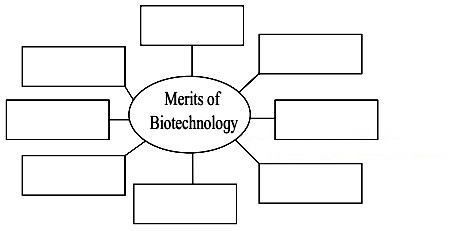
Answer:
Question 7.
Write the correct answer in blank boxes.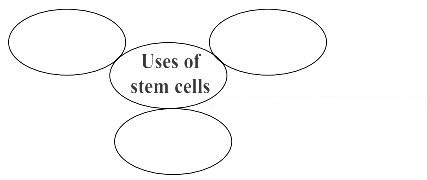
Answer:
Question 8.
Identify and complete the following correlations:
a. Insulin : Diabetes : : Interleukin : …………….
Answer:
Insulin : Diabetes : : Interleukin : Cancer
b. Interferon : ………. : : Erythropoietin : Anaemia.
Answer:
Interferon : Viral infection : : Erythropoietin : Anaemia.
c. ……….. : Dwarfness : : Factor VIII : Haemophilia.
Answer:
Somatostatin : Dwarfness : : Factor VIII : Haemophilia.
d. White revolution : Dairy : : Blue revolution : ………
Answer:
White revolution : Dairy : : Blue revolution : Fishery
Question 9.
Write a comparative note on usefulness and harmfulness of biotechnology.
(OR)
“Biotechnology is not only beneficial but it has some harmful effects too”. Express your opinion about this statement.
Answer:
(1) Biotechnology has proved to be useful in the field of agriculture, medicine, clean technology and industrial products.
(2) Due to various biotechnological experiments, the food production is increased substantially. The milk and milk products are now freely available. People no longer die of hunger due to abundant food supply.
(3) The sophisticated vaccines have stopped the spread of epidemics.
(4) The diseases like diabetes can be controlled due to human insulin injections that can be manufactured by biotechnology.
(5) The problems of pollution control, solid waste management and fuels are partially tackled by biotechnological alternatives.
(6) Though all such positive aspects are there, the biotechnology also poses some problems. The genetic changes are breaking the principles of nature. By inserting human genes in bacteria or virus, the products that are needed only for humans are produced.
(7) Human cloning is also a debatable issue. It will cause social and ethical problems. The new generations formed by cloning will have mothers but no fathers. If man tries to manipulate the genomes of other living organisms, it will cause disturbances in the natural balance. The long ternT effects of all such genetic manipulations can be disastrous. Thus, according to some views, biotechnology can be dangerous too.
Projects: (Do it your self)
Project 1.
Visit the organic manuring projects nearby your place and collect more information.
Project 2.
What will you do to increase public awareness about organ donation in your area?
Project 3.
Collect information about ‘green corridor’. Make a news-collection about it.
Can you recall? (Text Book Page No. 88)
Question 1.
What is cell?
Answer:
The structural and functional unit of the body is called a cell.
Question 2.
What is tissue? What are the functions of tissue?
Answer:
Tissue is a group of cells that performs a similar and definite function. E.g. The muscular tissues in the body perform contraction and extensions thereby helping in locomotion. The conducting tissues of the plants like xylem and phloem transport the water and food respectively.
Question 3.
Which technique in relation to tissues have you studied in earlier classes?
Answer:
The technique of tissue culture and genetic engineering has been studied last year. Tissue culture is ‘Ex vivo growth of cells or tissues in an aseptic and nutrient-rich medium’. Genetic engineering and its use has also been studied under, ‘Introduction to biotechnology’.
Question 4.
Which are the various processes in tissue culture?
Answer:
Various step-wise processes are done while performing the-tissue culture. These processes are primary treatment, reproduction/cell division/multiplication, shooting or rooting, primary hardening, secondary hardening, etc.
Observe: (Text Book Page No. 88)
Question 1.
Assign names in the figure given below. Explain the various stages those are kept blank:

Answer:
Tissue Culture: Tissue culture is the technique in which ‘ex vivo growth of cells or tissues in an aseptic and nutrient-rich medium’ is done. While performing experiments of tissue culture, a liquid, solid or gel-like ” medium prepared from agar, is used. Such medium supplies nutrients and energy necessary for tissue culture technique. Different processes are to be done while performing tissue culture, viz. primary treatment, reproduction or multiplication, shooting and rooting, primary hardening, secondary hardening, etc. From the source plant, required tissues are taken out and all the processes are carried in an aseptic medium in laboratory.
(Use your brain power. (Text Book Page No. 89)
Question 1.
Just like the grafting in plants, is the organ transplantation possible in humans?
Answer:
The grafting as done in case of plants, cannot be done in human beings. But the transplantation of certain organs can be done. Liver, kidney, heart, eyes, etc. can be transplanted. But for these transplantations the donor and the recipient should match with each other in respect of their bloodr groups, age, disease condition, etc. In future, the stem cell research can bring about certain changes in the field of transplantations.
(Text Book Page No. 94)
Question 1.
What will happen if the transgenic potatoes are cooked before consumption?
Answer:
Some types of transgenic potatotes that contain edible vaccine against Hepatitis can be cooked. The cooking does not destroy the antigen incorporated into these transgenic potatoes. But according to some scientists, transgenic potatoes with enterotoxin vaccine, if cooked shows denaturation of vaccine.
Choose the correct alternative and write its alphabet against the sub-question number:
Question 1.
The property of stem cells is called ………….
(a) diversity
(b) equality
(c) differentiation
(d) pluripotency
Answer:
(d) pluripotency
Question 2.
Cell ……….. starts from 14th day of conception.
(a) development
(b) specialization
(c) growth
(d) differentiation
Answer:
(d) differentiation
Question 3.
Availability of ………… is an important requirement in organ transplantation.
(a) doctor
(b) clinic
(c) donor
(d) ambulance
Answer:
(c) donor
Question 4.
The toxin which is lethal for ……….. was produced in leaves and bolls of BT cotton.
(a) bollworm
(b) locust
(c) birds
(d) frogs
Answer:
(a) bollworm
Question 5.
Transgenic raw potatoes generate the immunity against ………… disease.
(a) plague
(b) cholera
(c) leprosy
(d) TB
Answer:
(b) cholera
Rewrite the following wrong statements after corrections:
Question 1.
High-class varieties of crops have been developed through the technique of transplantation.
Answer:
High-class varieties of crops have been developed through the technique of tissue-culture.
Question 2.
Earlier, insulin was being collected from, the pancreas of pigs.
Answer:
Earlier, insulin was being collected from the- pancreas of horses.
Question 3.
Malaria arises due to genetic changes in hepatocytes.
Answer:
Phenylketonuria (PKT) arises due to genetic changes in hepatocytes.
Question 4.
The E.coli bacteria are useful for cleaning the hydrocarbon and oil pollutants from soil and water.
Answer:
The Pseudomonas bacteria are useful for cleaning the hydrocarbon and oil pollutants from soil and water.
Question 5.
Various essential elements like N, P, K are removed and hence become unavailable to the crops due to earthworms and fungi.
Answer:
Various essential elements like N, P, K become available to crops due to earthworms and fungi.
Question 6.
We do not have any tradition that cures the diseases with the help of natural resources.
Answer:
We have a great tradition of ayurveda that cures the diseases with the help of natural resources.
Match the pairs:
Question 1.
| Scientist | Contribution |
| (1) Dr. Anand Mohan Chakravarti | (a) Wheat production in America |
| (2) Dr. M. S. Swaminathan | (b) White revolution |
| (c) Green revolution in India | |
| (d) Cleaning the oil spill |
Answer:
(1) Dr. Anand Mohan Chakravarti – Cleaning the oil spill
(2) Dr. M.S. Swaminathan – Green revolution in India
Question 2.
| Organism | Substance that is absorbed |
| (1) Pseudomonas | (a) Uranium and arsenic |
| (2) Pteris vitata | (b) Selenium |
| (c) Arsenic | |
| (d) Hydrocarbons |
Answer:
(1) Pseudomonas – Hydrocarbons
(2) Pteris vitata – Arsenic
Find the odd man out:
Question 1.
Green revolution, Industrial revolution, White revolution, Blue revolution
Answer:
Industrial revolution. (All others are concerned with food.)
Question 2.
DDT, malathion, chloropyriphos, Humus
Answer:
Humus. (All others are insecticides.)
Question 3.
Sodium, Aluminium, Potassium, Phosphorus
Answer:
Aluminium. (All others are essential elements for plant growth.)
Question 4.
Diabetes, Anaemia, Leukaemia, Thalassemia
Answer:
Diabetes. (All other diseases involve reduction in the number of blood cells.)
Question 5.
Drying, Salting, Cooking, Soaking with sugar
Answer:
Cooking. (All others are food preservative methods.)
Identify and complete the following correlations:
Question 1.
White revolution : Increase in dairy production : : Green revolution : ………. (March 2019)
Answer:
White revolution : Increase in dairy production : : Green revolution : Increase in agricultural production or crop yield
Question 2.
Nostoc, Anabaena : Biofertilizers : : Alfalfa : ………..
Answer:
Nostoc, Anabaena : Biofertilizers : : Alfalfa : Phytoremediation.
Give definition/Give meanings:
Question 1.
Stem cell or what are stem cells?
Answer:
The special cells having pluripotency and ability to divide and differentiate into new cells are called stem cells. They are present in multicellular living beings.
Question 2.
Biotechnology.
Answer:
Technology that brings about artificial genetic changes and hybridization in organisms for human welfare is called biotechnology.
Question 3.
Genetically modified crops.
Answer:
Crops having desired characters are developed by integrating foreign gene with their genome, such crops have modified genome and are known as genetically modified crops.
Question 4.
Golden rice.
Answer:
Biotechnologically developed variety of rice in which gene synthesizing the vitamin A (Beta carotene) has been incorporated and which contains 23 times more amount of beta carotene than that of the normal variety is called golden rice. It was developed in 2005.
Question 5.
Vaccine.
Answer:
The ‘antigen’ containing material given to a person or animal to acquire either permanent or temporary immunity against a specific pathogen or disease is called a vaccine.
Question 6.
Cloning.
Answer:
Production of replica of any cell or organ or entire organism through biotechnological process is called cloning.
Question 7.
DNA fingerprint.
Answer:
The nucleotide sequence present on the DNA of each person is unique just like the fingerprint, thus for establishing the identity of any person DNA can be analysed, this technique is known as DNA fingerprinting.
Question 8.
Green revolution.
Answer:
All the methods applied for harvesting maximum yield from minimum land are collectively referred to as green revolution.
Question 9.
White revolution.
Answer:
Achieving the self-sufficiency in dairy business, by performing various experiments for quality control, bringing about newer dairy products and their preservation and thus raising economic standards is called white revolution.
Question 10.
Blue revolution.
Answer:
The aquaculture practices to increase the yield of edible aquatic organisms is called blue revolution.
Name the following:
Question 1.
Research institutes involved with cell science.
Answer:
- National Centre of Cell Science, Pune
- Instem, Bengaluru.
Question 2.
Sources of stem cells.
Answer:
- Umbilical cord
- Embryonic cells
- Redbone marrow
- Adipose connective tissue and blood of adult human being.
Question 3.
Types of Stem cells.
Answer:
- Embryonic stem cells
- Adult stem cells.
Question 4.
Organs that can be donated.
Answer:
Eyes, heart, pancreas, liver, kidneys, skin, J bones, lungs.
Question 5.
Organisms used as biofertilizers.
Answer:
Rhizobium, Azotobacter, Nostoc, Anabaena, Azolla.
Question 6.
Two main methods used in animal husbandry.
Answer:
- Artificial insemination
- Embryo transfer.
Question 7.
Two important aspects of human health management.
Answer:
- Diagnosis
- Treatment of diseases.
Question 8.
Place where DNA fingerprinting research is done in India.
Answer:
Centre of DNA fingerprinting and Diagnostics, Hyderabad.
Question 9.
One benefit of biotechnology to the agriculture.
Answer:
Expenses on the pesticides are reduced.
scientific reasons:
Question 1.
Nowadays, safer vaccines are being produced.
Answer:
- Before the advent of biotechnology, the vaccines were made from inactive or dead pathogens of that disease.
- But now the vaccine is made artificially using biotechnological processes.
- Such vaccines produced some disease symptoms in some cases.
- The antigen of the disease is researched upon and its genetic code is found out.
- A similar antigen is made in the laboratories which is used as a vaccine.
- Such vaccines are more thermostable and remain active for longer duration. Therefore, the vaccines are now safer.
Question 2.
Awareness about organ donation after death is increasing.
Answer:
- Due to accidents or illness, some of the vital organs may get damaged and may not work to fullest capacity.
- In such cases, if organ transplantation is done, it will be very helpful for that needy patient.
- The dead person’s organs can be used for organ transplantation and a life can be saved.
- Many government and social organizations are spreading awareness about such donations. Therefore, gradually the awareness about organ transplantation is increasing.
Answer the following questions:
Question 1.
Write two uses of biotechnology related to human health. (Board’s Model Activity Sheet)
Answer:
- Biotechnology is used to manufacture vaccines for controlling diseases.
- Different hormones such as insulin, somatotropin and somatostatin can be prepared in laboratories by using new biotechnological processes. The clotting factors are also manufactured through such techniques.
Question 2.
Answer the following questions:
(a) What is biotechnology?
(b) Explain any two commercial applications of it. (March 2019)
Answer:
(a) Biotechnology: Technology that brings about artificial genetic changes and hybridization in organisms for human welfare is called biotechnology.
(b)
- The treatment and prevention of diseases need hormones, interferons, antibiotics and different vaccine which are now manufactured through biotechnology. Gene therapy is also used to treat hereditary disorders.
- Industrial products and clean technology to combat environmental pollution uses biotechnology practices.
- DNA fingerprinting has revolutionized the profession of forensic science.
Question 3.
What is mainly included under biotechnology?
Answer:
Biotechnology includes the following main areas:
- Abilities of microbes are used in producing yoghurt from milk and making alcohol from molasses.
- Production of antibiotics and vaccines, etc. is carried out by with the help of specific cells using their productivity.
- Bio-molecules like DNA and proteins are used for human welfare.
- By performing gene manipulation, plants, animals and products of desired quality are produced. Genetically modified bacteria are used to produce human hormones such as Human Growth Hormone and insulin.
- Tissue culture is a non-genetic technique which is used for production of new cells or tissues. Hybrid seeds are also produced in a similar way.
Question 4.
What are edible vaccines?
Answer:
- Edible vaccines are those which are given as a food by incorporating them into the food-stuff.
- Such edible vaccines are produced through biotechnology.
- Transgenic potatoes are produced with the help of biotechnology which contain vaccine that act against bacteria like Vibrio cholera, Escherichiatoli.
- If raw potatoes are consumed, then the immunity is generated in the body of a person. However, eating only raw potatoes generates the immunity against cholera and the disease caused due to E. coli.
Question 5.
What is DNA fingerprinting? Explain it in brief. Where is this technique used? Give any two examples. (Board’s Model Activity Sheet)
Answer:
- As the fingerprints are unique for every individual, similarly the nucleotide sequence in the DNA molecule is also unique.
- By knowing this sequence, one can find out the identity of any person. Such technique to establish the identity of a person by taking into consideration the nucleotide sequence is called DNA fingerprinting.
- Its main use is in forensic sciences to confirm the identity of the criminal.
- Similarly, identity of parents in case of disputed parentage for any child can be understood by taking DNA fingerprints of both the parents and a child.
Write short notes on:
Question 1.
Uses of stem cells.
Answer:
Stem cells are used for following purposes:
- In regenerative therapy stem cells are used.
- In case of diseased conditions like diabetes, myocardial infarction, Alzheimer’s disease, Parkinson’s disease, etc., stem cells can be used to replace the damaged or functionless cells.
- In conditions such as anaemia, thalassaemia, leukaemia, etc. there is always the need of newer blood cells. Here, stem cells can be used to restore the number of blood cells.
- In techniques of organ transplantation stem cells can be used and they can help in the transplantation of new organs such as kidney and liver The defective organs can be replaced by those that are produced with the help of stem cells and transplanted.
Question 2.
Cloning.
Answer:
- Cloning is the modern technique in which there is production of replica of any cell or organ or entire organism is done.
- There are two types of cloning, viz. (i) Reproductive cloning and (ii) Therapeutic cloning.
- Reproductive cloning: In reproductive cloning, a clone is produced by fusion of a nucleus of diploid somatic cell with the enucleated ovum of anybody. In the process, the sperm or male gamete is not needed.
- Therapeutic cloning: This technique is largely used for treatment purpose. Stem cells are derived from the cell formed in laboratory by the union of somatic cell nucleus with the enucleated egg cell.
- This technique is used for therapy of various diseases.
- Gene cloning can also be done to form millions of copies of same gene. Such genes are used for gene therapy and other purposes.
- Due to cloning technique, the inheritance of hereditary diseases can be controlled, continuation of generations can be achieved and certain characteristic genes can be enhanced.
- However, for human cloning, there is world-wide opposition due to ethical reasons.
Question 3.
Dolly.
Answer:
- Dolly was the first mammalian cloned sheep.
- Dolly was born on 5th July 1996 in Scotland by the process of cloning.
- The Finn Dorset sheep was chosen and her diploid nucleus from the udder cell was introduced into the ovum whose haploid nucleus was removed. This enucleated ovum was of Scottish sheep.
- The egg was then introduced into uterus of another Scottish sheep and it grew into Dolly.
- Dolly resembled exactly like Finn Dorset sheep whose diploid nucleus was used. None of the characters of Scottish sheep were seen in Dolly.
- In this way, Dolly had three mothers but no father.
- Dolly gave birth to many young ones. She died on 14th February 2003 due to cancer of the lungs.
Question 4.
Green revolution.
Answer:
- In agriculture, different methods used to harvest maximum yield from minimum land, these methods are collectively called green revolution.
- Dr. M.S. Swaminathan is called father of Green Revolution in India while Dr. Norman Borlaug has done the similar efforts in the U.S.
- Before the Green Revolution in India, there was always the dearth of the food grains. The overflowing Indian population was badly affected due to poor quality and quantity of food.
- But due to the Green Revolution in India, attention was focussed on the agricultural research.
- Improvised dwarf varieties of wheat and rice, proper use of fertilizers and pesticides and water management were the proper methods that increased production of food grains.
- This created abundance of the grains for Indian population.
Question 5.
White revolution.
Answer:
- Few years back, there was scarcity of milk in various parts of India. At some places, milk and milk products were abundant but they did not reach all the consumers.
- Dr. Verghese Kurien ^ho was then the founder director of Anand Milk Union Limited (AMUL) started thecooperative movement in the direction to produce “operation flood”, i.e. abundance of milk everywhere.
- The use of biotechnology was also done to increase the milk production.
- Dr. Kurien’s efforts have reached all-time high status as India is now self-sufficient in dairy business.
- This is popularly known as White Revolution. Different experiments were performed for quality control, newer dairy products were thought off and preservation methods were improved.
- This created White Revolution. AMUL from Anand has now reached international standards.
Question 6.
Blue Revolution.
Answer:
- Utilization of aquaculture practices for obtaining edible and commercial aquatic organisms is called blue revolution.
- In East Asian countries where water bodies and fish population is abundant, the aquaculture was started.
- On similar lines, in India, the aquaculture of different fresh water and marine organisms is being done with the help of fishery scientists.
- Government of India has vowed to increase the aquaculture production by encouraging the people for aquaculture by launching the program ‘Nil- Kranti Mission-2016’ (NKM-16).
- Pisciculutre is culturing of fish, mariculture is culture of marine organisms such as prawns/shrimps and lobsters. Sea weeds, oysters, clams are also cultured.
- For carrying out aquaculture, 50% to 100% subsidies are offered by the Government.
- Fresh water fishes like rohu, catla and other edible varieties like shrimp and lobsters are being cultured on a large scale which can bring about Blue Revolution.
Complete the paragraph by choosing the appropriate words given in the bracket:
Question 1.
(degenerated, red bone marrow, adipose connective tissue, blastocyst, umbilical cord, Differentiation)
………… of stem cells form can form various tissues, in the body. Stem cells are present in the ………….. by which the foetus is joined to the uterus of the mother. Stem cells are also present in the ……….. stage of embryonic development. Stem cells are present in ……….. and ………… of adult human beings. It has become possible to produce different types of tissues and the ……… part of any organ with the help of these stem cells.
Answer:
Differentiation of stem cells form can form various tissues in the body. Stem cells are present in the umbilical cord by which the foetus is joined to the uterus of the mother. Stem cells are also present in the blastocyst stage of embryonic development. Stem cells are present in red bone marrow and adipose connective tissue of adult human beings. It has become possible to produce different types of tissues and the degenerated part of any organ with the help of these stem cells.
Paragraph-based questions :
1. Green corridor refers to a special road route that enables harvested organs meant for transplants to reach the destined hospital. A 45-year-old woman, a victim of a railway accident, was declared brain dead, her husband and children agreed to donate her kidneys, liver and heart. One of her kidneys was transplanted to a patient in MGM Hospital and the second kidney helped a patient in Jaslok hospital. Her liver helped the transplant of a patient in Wockhardt Hospital. And her heart was sent to Fortis to the patient on a super urgent priority list, transported via a green corridor covering 18km in less than 16 minutes. This was possible due to Green corridor.
Questions and Answers :
Question 1.
What is Green corridor?
Answer:
Green corridor is a special road route that enables harvested organs meant for transplants to reach the destined hospital
Question 2.
Which organs of brain-dead lady were transplanted?
Answer:
Two kidneys, liver and heart of the brain- dead lady were transplanted.
Question 3.
How many lives were saved from organs of one lady?
Answer:
Four patients lives were saved due to organ donation of one lady.
Question 4.
How was distance of 18km covered in 16 minutes? Why?
Answer:
The distance was covered because the concept of Green corridor was applied. The heart was sent from one hospital to another, where the recipient was kept ready. The quick transportation is necessary to keep heart in living condition.
Question 5.
Who takes the decision to donate the organs?
Answer:
The close relatives of deceased person take the decision to donate the organs.
2. Read the following extract and answer the questions that follow: (March 2019)
A liberal view behind the concept of organ and body donation is that after death our body should be useful to other needful persons so that their miserable life would become comfortable. Awareness about these concepts is. increasing in our country and people are voluntarily donating their bodies.
Life of many people can be saved by organ and body donation. Blinds can regain their vision. Life of many people can be rendered comfortable by donation of organs like liver, kidneys, heart, heart valves, skin, etc. Similarly, body can be made available for research in medical studies. Many government and social organizations are working towards increasing the awareness about body donation.
Questions and Answers :
Question 1.
What is the liberal view behind the organ and body donation?
Answer:
By body donation, research in medical studies is possible. The needy persons can get vital organs which can save their lives.
Question 2.
Name any four organs that can be donated.
Answer:
Liver, Kidneys, heart, eyes, skin, etc. can be donated.
Complete the following table:
Question 1.
| Plant/Microbes | Functions |
| (1) Pteris vitata | ______________________________ |
| (2) Pseudomonas | ______________________________ |
| (3) ______________________________ | Absorption of uranium and arsenic |
| (4) ______________________________ | Absorption of radiations of nuclear waste |
Answer:
| Plant/Microbes | Functions |
| (1) Pteris vitata | Absorbs arsenic from soil. |
| (2) Pseudomonas | Separates hydrocarbon and oil from water and soil |
| (3) Sunflower | Absorption of uranium and arsenic |
| (4) Deinococcus radiodurans | Absorption of radiations of nuclear waste |
Diagram/chart based questions:
Question 1.
(A) Which process is shown in the above figure? *
Answer:
The figure shows process to make transgenic
(B) Describe in brief the steps I, II, III and IV.
Answer: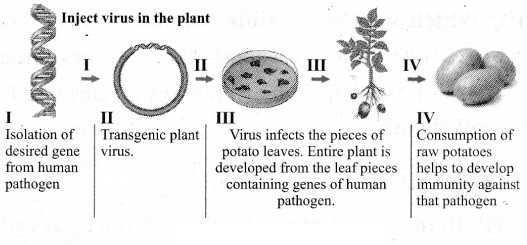
Question 2.
Draw well labelled diagram of Stem cell therapy.
Answer: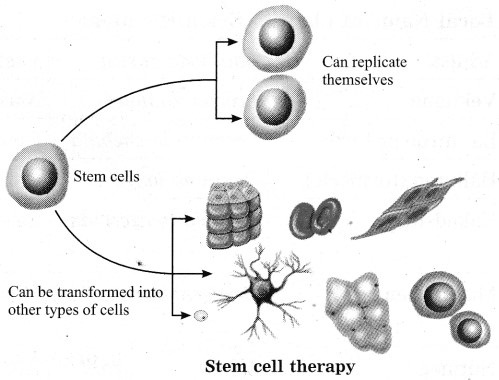
Question 3.
Label the following diagram :
(i) Stem cells and organ transplantation,
Answer:
(ii) Organs that can be donated:
Answer: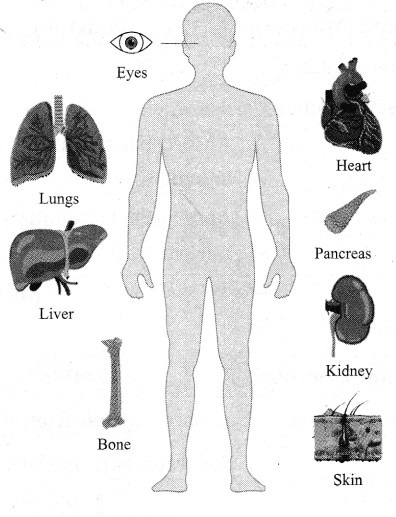
Question 4.
(i) Which therapy is shown in the Fig. 8.5?
(ii) Which will be possible benefits of this therapy in organ transplantation ?
Answer:
(i) The figure 8.5 shows the ‘regenerative therapy’ using stem cells. Also called stem cell therapy.
(ii) With the help of above therapy organs like liver, kidney from stem cells can be redeveloped to replace the failed ones.
Activity based questions:
Question 1.
Bring a packet of ‘Balghuti’ from ayurveda shop. Learn the information about each component in it. Collect information about various other medicines and prepare the chart as shown below. (Try this: Textbook page no. 99)
Answer:
Question 2.
Give five examples of each of the fruiting and flowering plants developed through tissue culture and mention their benefits. (Make a list and discuss: Textbook page no. 93)
Answer:
I. Fruiting trees: Banana, Chikoo (Sapota), Tomato, Fig, Pineapple.
II. Flowering trees: Orchids, Roses, Chrysanthemum, Gerbera, Begonia, Carnation, Lili. Benefits of such plants may be varied. Mostly fruits developed are made seedless and tastier.
III. Benefits of plants produced through technique of tissue culture:
- Techniques of tissue culture can produce more copies of same plant with better characters. ’ The plant grower likes to have bigger and more fruits from fruit trees. On the flowering trees, colourful flowers with good fragrance are favoured.
- Plants which do not depend on particular climate and local seasonal changes are produced by tissue culture methods. This helps to rise the yield in an area which otherwise may not produce a specific crop.
- For tissue culture, saplings and seedlings are made available throughout the year through laboratory. The limitations of getting natural seeds are not there thus planting can be done throughout the year.
- Tissue culture techniques create the plants of uniform size, shape and yield. Since they are exactly alike, it becomes beneficial.
- In lesser time period, the crops reach maturity.
- The crops are pest and disease resistant.
- Tissue culture techniques are cost effective and easy to carry out.
Question 3.
Which new species of the rice have been developed in India? (Collect Information: Textbook page no. 97)
Answer:
- Species in 2015-16: High zinc species (DRR Dhan 45), Pusa 1592, Punjab basmati 3, Pusa 1609, Telangana Sona.
- Species in 2014: CR Dhan 205, CR Dhan 306, CRR, 451.
Question 4.
Discuss about stem cells and organ transplantation in the class with the help of figures given on textbook page no. 90. (Observe: Textbook page no. 90)
Answer: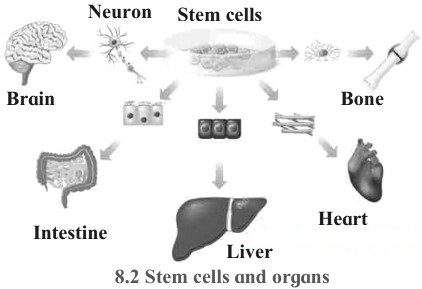
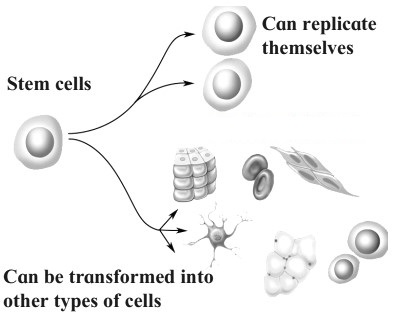
Organ transplantation:
Various organs in the human body either become less efficient or completely functionless due to various reasons like aging, accidents, infections, disorders, etc. Life of such person becomes difficult or even fatality may occur under such conditions. However, if a person gets the necessary organ under such conditions, its life can be saved.
Availability of donor is an important requirement in organ transplantation. Each person has a pair of kidneys. As the process of excretion can occur with the help of single kidney, person can donate another one. Similarly, skin from certain parts of the body can also be donated.
Various factors like blood group, diseases, disorders, age, etc. of the donor and recipient need to be paid attention during transplantation.
However, other organs cannot be donated during life time. Organs like liver, heart, eyes can be donated after death only. This has lead to the emergence of concepts like posthumous (after death) donation of body and organs.
Organ and Body Donation: human bodies are disposed off after death as per traditional customs. However due to progress in science, it has been realized that many organs remain functional for certain period even after death occurs under specific conditions. Concepts like organ donation and body donation have emerged recently after realization that such organs can be used to save the life of other needful persons. A liberal view behind the concept of organ and body donation is that after death, our body should be useful to other needful persons so that their miserable life would become comfortable. Awareness about these concepts is increasing in our country and people are voluntarily donating their bodies.
Life of many people can be saved by organ and body donation. Blinds can regain the vision. Life of many people can be rendered comfortable by donation of organs like liver, kidneys, heart, heart valves, skin. etc. Similarly, body can be made available for research in medical studies. Many government and social organizations are working towards increasing the awareness about body donation.
Question 5.
Which fruits processing industries you observe in your surrounding? What is their effect? (Make a list and discuss: Textbook page no. 99)
Answer: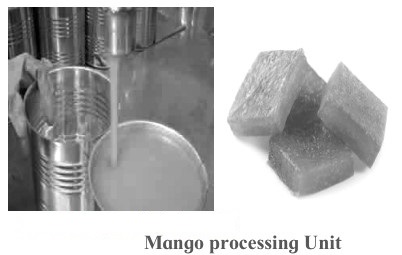
Fruit Processing:
we are daily using various products prepared from fruits. All are consuming the products like chocolates, juices, jams and jellies. All these products can be produced by processing on fruits. Fruits are perishable agro-produce. It needs the processing in such a way that it can be used throughout the year. Fruit processing includes various methods ranging from storage in cold storage to drying, salting, air tight pucking, preparing murabba, evaporating, etc.
Projects: (Do it your self)
Project 1.
Collect information about various hybrid varieties of animals. What are their benefits? Make a presentation of various pictures and videos. (Use of ICT: Textbook page no. 93)
Project 2.
Visit the websites: http://www.who.int/transplantation/organ/en/ and www.organindia.org / approaching-the- transplant/and collect more information about ‘brain dead’, organ donation and body donation (Internet is my friend: Textbook page no. 90)
Project 3.
Collect more information about the Human Genome Project, one of the important projects in the world.
(Internet is my friend: Textbook page no. 95)
Project 4.
Collect the information and make the chart about the work of various state and national-level institutes related with biotechnology. (Internet is my friend: Textbook page no. 97)
